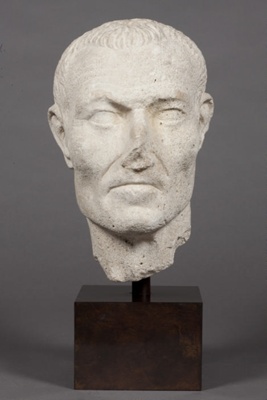< Collection search
< Collection highlights
From:UC Teece Museum of Classical Antiquities
Name/TitleLimestone portrait head
About this objectThis slightly larger-than-life head is believed to be a portrait of an aristocrat from Central Italy living in the middle of the first century BCE. It is carved from a cream coloured clastic limestone which is common to Central and Southern Italy. Clastic limestone is chemically identical to marble, but less dense which makes it easier to work with. The surface of the bust is quite rough, and the tip of his nose has broken off.
The portrait is a mix of Italo-Roman veristic style with Hellenistic elements. Verism was commonly used for portraits of politicians in the Republican period, as it's realistic "warts and all" style highlighted the imperfections and wrinkles that gave a sense of age, dignity and wisdom to the man portrayed. This portrait shows deep grooves around the mouth and furrowing on the forehead and between the eyes, while the sunken cheeks highlight his strong cheekbones. Two vertical folds on the left cheek could indicate scarring. His short wavy hair is receding at the temples; it is combed forward at the front and shown fairly thick in the back.
Some Hellenistic features are combined into this traditionally Italian style, with the head raised slightly and angled to one side rather than strictly frontal. The sculptor has also played with the effects of light and shade, giving a Hellenistic Greek touch to the Roman style that is meant to evoke the traditional values of firmness and conservatism.
Date MadeMid 1st Century BCE
PeriodRepublican
Place MadeItaly
Medium and MaterialsStone: Limestone
Style and IconographyHellenistic
Style and IconographyRoman
TechniqueCarving (processes)
MeasurementsH 314mm x W 200mm
Subject and Association KeywordsFigurative art
Named CollectionThe James Logie Memorial Collection, University of Canterbury, New Zealand
Credit LinePurchased, 1984.
Object TypeSculpture
Object number170.84
Copyright LicenceAll rights reserved


